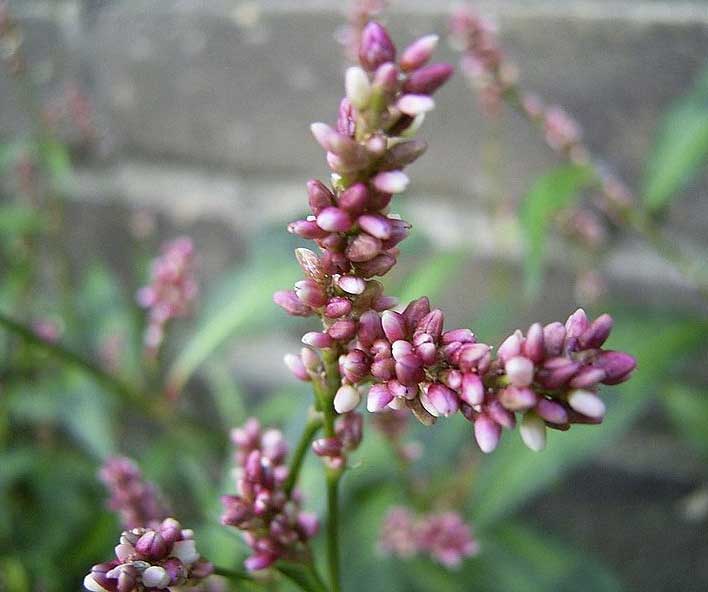
Persicaria maculosa (*)
Classification System: APG IV
Superregnum: Eukaryota
Regnum: Plantae
Cladus: Angiosperms
Cladus: Eudicots
Cladus: Core eudicots
Ordo: Caryophyllales
Familia: Polygonaceae
Subfamilia: Polygonoideae
Tribus: Persicarieae
Subtribus: Persicariinae
Genus: Persicaria
Species: Persicaria maculosa
Name
Persicaria maculosa Gray
Synonyms
Polygonum persicaria L.
References
Rodríguez, R.A., Marticorena, C.F.S., Alarcón, D., Baeza, C.M., Cavieres, L., Finot, V.L., Fuentes, N., Kiessling, A., Mihoc, M., Pauchard, A., Ruiz, E., Sanchez, P. & Marticorena, A.E. 2018. Catálogo de las plantas vasculares de Chile. Gayana. Botánica 75(1): 1–430. DOI: 10.4067/S0717-66432018000100001 Reference page.
Vernacular names
azərbaycanca: Qırmızıbaş qırxbuğum
башҡортса: Геморрой үләне
català: Persicària
čeština: Rdesno červivec
Cymraeg: Y ganwraidd goesgoch
dansk: Fersken-Pileurt
Deutsch: Floh-Knöterich
English: Lady's Thumb
español: Duraznillo
euskara: Astapiper
فارسی: پرسیکاریا ماکولسا
suomi: Hanhentatar
français: Renouée persicaire
hornjoserbsce: Blečkata wuroć
magyar: Baracklevelű keserűfű
Ido: Persikario
italiano: Poligono Persicaria
ქართული: ბოსტნის წალიკა
қазақша: Айланшөп
lietuvių: Dėmėtasis rūgtis
latviešu: Blusu sūrene
Nederlands: Perzikkruid
norsk nynorsk: Vanleg hønsegras
polski: Rdest Plamisty
português: Cristas
русский: Горец почечуйный
slovenčina: Horčiak broskyňolistý
Seeltersk: Smaatekaan
svenska: Åkerpilört
українська: Гірчак почечуйний
中文: 春蓼
Persicaria maculosa (syn. Polygonum persicaria) is an annual plant in the buckwheat family, Polygonaceae. Common names include lady's thumb,[2] spotted lady's thumb, Jesusplant, and redshank.[3][4] It is widespread across Eurasia from Iceland south to Portugal and east to Japan.[5][6] It is also present as an introduced and invasive species in North America, where it was first noted in the Great Lakes region in 1843 and has now spread through most of the continent.[7][8]
Inflorescence
The ochrea: stipules fused around the stem
Description
Persicaria maculosa is an annual herb up to 1 metre (3 ft 3 in) tall,[9] with an erect, rather floppy stem with swollen joints. The leaves are alternate and almost stalkless. The leaf blades often have a brown or black spot in the centre and are narrowly ovate and have entire margins. Each leaf base has stipules which are fused into a stem-enclosing sheath that is loose and fringed with long hairs at the upper end. The inflorescence is a dense spike. The perianth of each tiny pink flower consists of four or five lobes, fused near the base. There are six stamens, two fused carpels and two styles. The fruit is a shiny black, three-edged achene. This plant flowers from July to September in the temperate Northern Hemisphere.[6][10][11]
Taxonomy
The species was first described, as Polygonum persicaria, by Carl Linnaeus in 1753.[12] It was first successfully transferred to the genus Persicaria by Samuel Frederick Gray in 1821, under the name Persicaria maculosa.[13] The name "Persicaria persicaria" cannot be used because tautonyms – binomial names that use the same word for both the genus and the species epithet – are prohibited by the International Code of Nomenclature for algae, fungi, and plants, and a replacement name (nomen novum) must be used.[14] For this reason the transfer of the species to Persicaria by John Kunkel Small in 1903, which used the tautonym, is invalid.[15]
Distribution and habitat
Persicaria maculosa is native to Europe and Asia, where it can be mistaken for Polygonum minus. The latter has narrower leaves, usually less than 1 cm wide. It has been introduced to North America and is naturalised throughout the mainland continent,[16] growing along roadsides, riverbanks, and on fallow ground. In the United States, it is very similar to Pennsylvania smartweed, but redshank has a fringe of hairs at the top of the ochrea, something which Pennsylvania smartweed lacks. The species has also been found in New Zealand and Australia.[17][18]
Ecology
In the British Isles, this plant is a weed, without natural habitat, and always associated with human activity.[19] It likes moist soils, particularly rich ones, and acid peaty loams.[20] It does not like lime, and liming is cited as a means to fight it.[21][22]
Cultivation and uses
Persicaria maculosa contains persicarin and tannins. The young leaves may be eaten as a leaf vegetable.[9] It is often seen as a weed and rarely cultivated. A yellow dye can be produced from this plant with alum used as a mordant.
References
Tropicos, Persicaria maculosa Gray
"Polygonum persicaria". Integrated Taxonomic Information System. Retrieved 15 October 2007.
BSBI List 2007 (xls). Botanical Society of Britain and Ireland. Archived from the original (xls) on 2015-06-26. Retrieved 2016-08-16.
"Persicaria maculosa". Germplasm Resources Information Network (GRIN). Agricultural Research Service (ARS), United States Department of Agriculture (USDA). Retrieved 2017-12-18.
Altervista Flora Italiana, Persicaria maculosa Gray includes photos and European distribution map
Flora of China, Polygonum persicaria Linnaeus, 1753. 蓼 liao
"List of invasive species in the Great Lakes Great Lakes United / Union Saint-Laurent Grands Lacs". Archived from the original on 2009-04-29. Retrieved 2009-02-07.
Biota of North America Program 2014 state-level distribution map
Elias, Thomas S.; Dykeman, Peter A. (2009) [1982]. Edible Wild Plants: A North American Field Guide to Over 200 Natural Foods. New York: Sterling. p. 110. ISBN 978-1-4027-6715-9. OCLC 244766414.
"Redshank: Persicaria maculosa". NatureGate. Retrieved 2013-12-30.
Flora of North America, Persicaria maculosa Gray, 1821. Spotted lady's-thumb, redshank, renouée persicaire
"Polygonum persicaria L." International Plant Names Index (IPNI). Royal Botanic Gardens, Kew. 2019-05-09. Retrieved 2019-05-09.
"Persicaria maculosa Gray". International Plant Names Index (IPNI). Royal Botanic Gardens, Kew. 2019-05-09. Retrieved 2019-05-09.
International Code of Nomenclature for algae, fungi, and plants (Melbourne Code) see section 23.4
"Persicaria persicaria Small". International Plant Names Index (IPNI). Royal Botanic Gardens, Kew. 2019-05-09. Retrieved 2019-05-09.
USDA
Atlas of Living Australia, Persicaria maculosa Gray, Jesus Plant
IUCN Red List of Threatened Species, Persicaria maculosa
Simmonds, N W (1945). "Biological flora of the British Isles. Polygonum L". Journal of Ecology. 33 (33): 117–143. doi:10.2307/2256567. JSTOR 2256567.
Long, H. C. (1938). "Weeds of arable land". MAFF Bulletin (108).
Fenton, E. W. (1931). "Poisonous and milk-staining plants". Pamphlet of Edinburgh and East of Scotland College of Agriculture. New series (4): 7–31.
Bond, W. "The biology and non chemical control of Redshank (Persicaria maculosa Gray)". HDRA. Retrieved 13 October 2013.
Retrieved from "http://en.wikipedia.org/"
All text is available under the terms of the GNU Free Documentation License

